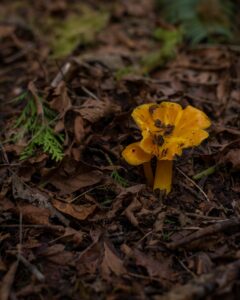If eyes are the windows to the soul, mushrooms might be the window to the soil. Fungi are indicators of diversity, burned carbon, the abundance of microbes, or the lack thereof. An undergrowth of fungi could indicate a healthy microbiome or a damaged one, based on what kind of fungi is fruiting and when. Mushrooms are not necessarily the problem – they are more likely to be indicators of an underlying chemical profile, just as the whites of a person’s eyes being yellow might be an indicator of a failing liver.

A hidden world of inter-species communication
We rarely even see most mushroom species that exist beneath the soil, the mycorrhizal or endophytic varieties. Mycorrhizal mushrooms associate with and form relationships with the roots of trees and plants. These fungi deep in the soil create a plethora of photosynthesizing organisms, sending their messages across the forest floor, offering various organisms access to minerals they would not otherwise be able to reach. Amazingly, they can sense when a tree on the other side of the forest is in need and can distribute water or minerals to that tree based on this awareness.
Fungi as health indicators
We are constantly witnessing the consequences of our technologically curious and ignorant culture. One example is the process of extracting and refining metals, which was undertaken before fully understanding their properties. That ignorance led to “Mad Hatters” disease (mercury poisoning) and lead paint poisoning. What would have alerted us to the fact that leaded glass would lead to kidney disease, except a five- or ten-year study? Who knew treated lumber and the manufacturing of long-lasting tires would be implicated in the die-off of several salmon species, short of a 20-year study? We just can’t be clear on how things will affect the natural world without lengthy, double-blind studies. Unless, that is, we observe nature and heed her messages.
Candida albicans is a fungus that lives in the human body. When in balance, Candida helps us digest food and chelate otherwise harmful heavy metals. Most health “experts” emphasize the negativity of Candida’s presence and the internet is full, mostly, of information on how to get rid of it.
What is less understood is that Candida may be present in internal human environments because it is an indicator of a larger problem like heavy metal accumulation. Perhaps we should not try to eradicate Candida as much as understand why it proliferates in humans. In much the same way, mushrooms can alert us to environmental problems and point to their solutions. Cultivated fungi are now being used around the world to remediate heavy metal pollution in the soil. Rather than being the cause of the imbalance, fungi are often the first indicators of a problem, also serving on the clean-up crew.
Respecting the messages of fungi
Our medical system typically makes treatment choices based on symptoms. Even when we know health problems are systemic and deeply rooted, we persist in prescribing treatments based on outer symptoms. Perhaps when they see an organism that annoys them, like a mushroom that blooms on the lawn after a rain, humans can learn to think about all the underlying reasons why something so inherently misunderstood would present itself. What could their presence be implying? What could they possibly be trying to tell us? It could be an entire network of organisms, talking to each other and making decisions about how to orchestrate remediation of an unhealthy situation.
We know network systems of fungi communicate with each other. More than likely, they are talking smack about how intolerant humans are of organisms that are merely cleaning up after them. However, based on what I know about fungi, they’re probably just having little spore parties and making plans to bring more phosphorus to Sheldon, the elder tree in the forest whose topsoil is stripped due to foot traffic at the entrance of the state park.
Ava Arvest is a mycologist and owner of Mycouprrhizal. Ava organizes classes and workshops and organizes events to educate and empower people surrounding the use of fungi. Learn more at mycouprrhizal.wordpress.com or visit the Mycouprrhizal booth at the Olympia Farmers Market.
Photo by Lindsey Dalthorp
Luv it. I learned somethin new about Candida. Your writer’s voice is cool. Thanks Ava 😉